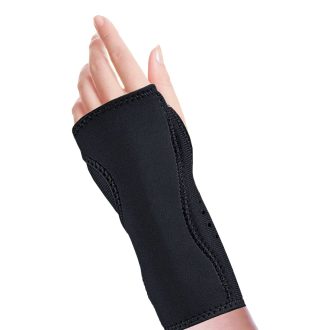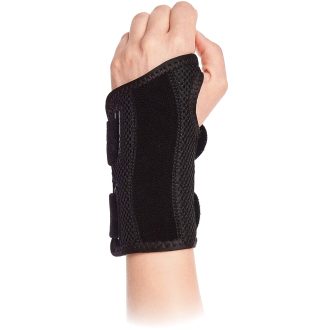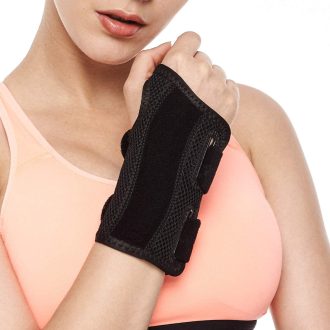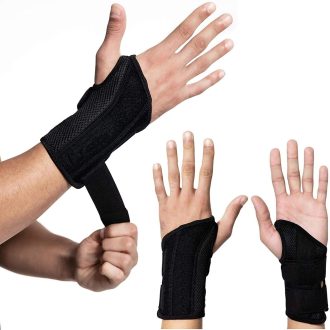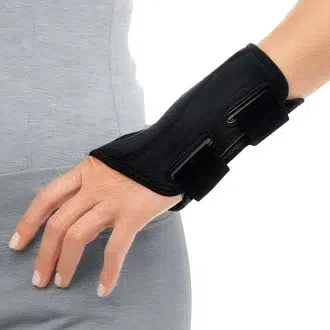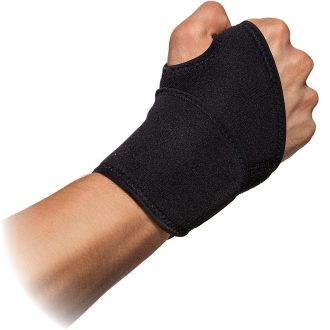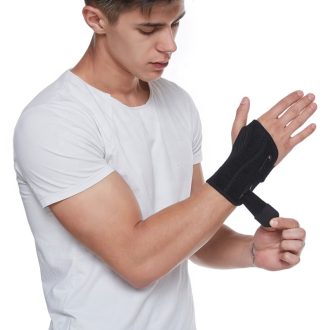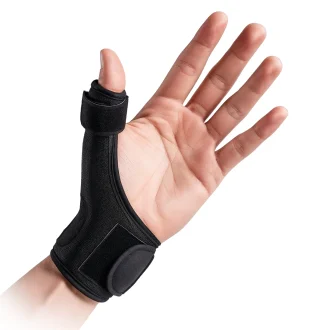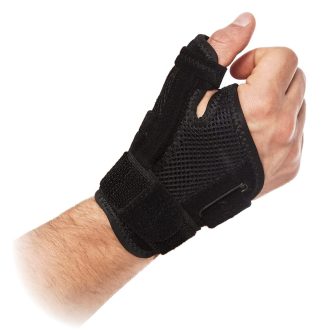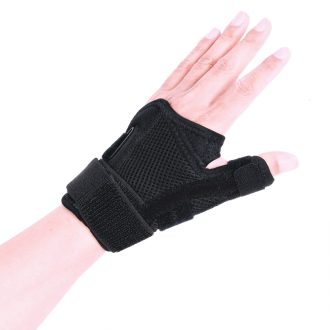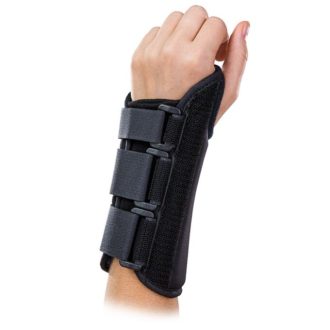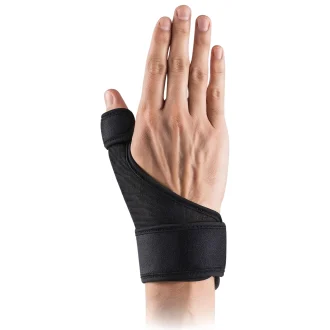No products in the cart.
Wrist Supports
Welcome To Our Wrist Supports & Braces Collection
At NuovaHealth, we understand how challenging wrist pain and injury can be—affecting your work, hobbies, and daily tasks. Whether you’re recovering from a sudden injury or managing a long‑term condition, the right support helps restore comfort and function, and is recommended in conservative care according to guidance from the National Health Service and the National Institute for Health and Care Excellence.
Understanding Wrist Pain & Injury
Your wrists and hands work hard every day, relying on small bones, tendons, ligaments, and nerves to coordinate movement. When these structures are irritated or injured, pain, stiffness, and restricted motion can quickly affect daily life. Common problems include sprains after a twist or fall, fractures following impact, carpal tunnel syndrome from median nerve compression, tendon irritation from repetitive use, and arthritis—both osteoarthritis and inflammatory types—causing joint pain and reduced mobility. If symptoms persist, a clinical assessment helps confirm the cause and guide care.
Why The Right Support Matters
Using an appropriate wrist support can be a key part of conservative care. As outlined in guidance from the National Health Service and the National Institute for Health and Care Excellence, bracing or splinting helps protect injured tissues, reduce painful motion, and support a safer return to activity when used alongside rest, graded exercise, and other treatments. The aim is to limit strain while you heal, improve day‑to‑day comfort, and lower the risk of further irritation.
How To Choose
Selecting the right wrist support is easier when you match features to your symptoms, activities, and wear time.
- Your condition and severity:
- Mild to moderate pain or irritation: choose lighter stabilisation that holds a neutral wrist for daily tasks.
- Acute injury or post‑procedure: follow clinical advice; begin with firmer stabilisation, then step down as symptoms settle.
- Thumb inclusion:
- Choose a design with thumb support (thumb spica) for thumb‑side (radial) pain, De Quervain’s patterns, or when extra control around the base of the thumb helps comfort.
- A standard wrist design suits central or ulnar‑side symptoms when thumb motion is comfortable.
- Support level:
- Firmer stabilisation for flare‑ups and protection during early recovery.
- Lighter, more flexible support for daytime use and return to activity.
- Day or night wear:
- Night: prioritise neutral alignment and cushioned contact points for comfort.
- Day: choose a low‑profile design that fits under sleeves and allows light functional movement while maintaining alignment.
- Fit and handedness:
- Check left/right options where relevant and choose the side that matches your affected hand.
- Comfort features:
- Look for breathable liners, soft edges, and easy, secure straps if you’ll wear the support for extended periods.
- Activity needs:
- For desk or manual work, consider slimmer profiles and durable materials; for sport, look for stable yet flexible designs that don’t impede grip.
- Plan to progress:
- Start with steady stabilisation during painful phases, then transition to lighter support as confidence and control return.
Immobilization For Healing
Holding your wrist in a neutral, stable position discourages movements that can aggravate symptoms. This is especially important after fractures or significant sprains, where controlled immobilization supports proper healing of bone and ligament and helps prevent complications. Clinical guidance highlights neutral positioning to protect repairs and align healing tissues during early recovery.
Compression For Recovery
Targeted compression helps manage swelling and inflammation, which can reduce pain and make daily tasks more manageable. By supporting soft tissues and easing fluid build‑up, compression can improve comfort as range of motion gradually returns under clinical advice.
Ready To Find The Right Solution?
To help you choose effectively, the sections below explain how wrist supports and braces can assist with a wide range of wrist injuries and conditions, and how to use them responsibly as part of your recovery.
Conditions Our Wrist Supports And Braces Can Help With
Why Choose NuovaHealth
Choosing the right wrist support is an important step toward healing, prevention, and long-term wrist health. We are committed to helping you regain comfort and function by offering thoughtfully designed products that are thoroughly tested and trusted by healthcare professionals.
Designed For A Wide Range Of Wrist Needs
No two wrists or wrist conditions are exactly alike. Our collection spans solutions from mild support for minor strains to more robust braces for chronic injuries or post-surgical recovery. The range addresses acute injuries, repetitive strain, arthritis, tendonitis, carpal tunnel, and more, so you can select a support that aligns with your needs.
Tailored Fit & Versatility
Every wrist is unique, and so is every recovery. Our supports are available in a range of sizes with adjustable features to create a secure, personalized fit for different hand shapes and preferences. Whether you are typing, playing sports, driving, or doing household tasks, you can choose a NuovaHealth support that fits your day.
Discreet, All-Day Wear
Slim, low-profile designs allow discreet wear under clothing. Breathable materials and ergonomic contours make it easier to keep your wrist protected and comfortable throughout the day at work, at home, and during exercise.
Easy Maintenance For Everyday Use
Hygiene and convenience matter. Many of our wrist supports are machine washable or easy to wipe clean, and they are designed for regular, long-term use with minimal upkeep.
Expertly Designed & Thoroughly Tested
Our wrist supports are developed through collaboration between medical professionals, engineers, and therapists. Each product is carefully designed, tested in real-world use, and refined to deliver targeted support and reliable performance so you can focus on recovery.
Uncompromising Quality
Whether you are recovering from a sprain, managing arthritis, or seeking extra support for daily activities, NuovaHealth wrist supports provide consistent stability and comfort. They are made to last from premium materials that withstand everyday use while maintaining their shape and support.
Medical-Grade Materials
We use medical-grade, clinically trusted fabrics and components that are durable, effective, skin-friendly, and breathable. You can wear your support comfortably for hours, and many healthcare practitioners recommend our wrist supports for their reliability and performance.
Recommended By Professionals
Many of our products are endorsed or routinely prescribed by clinicians, therapists, and sports medicine professionals. Choosing NuovaHealth means selecting support that meets standards used in clinical settings.
Comprehensive Pain Relief & Enhanced Healing
NuovaHealth wrist supports do more than immobilize. Targeted compression helps reduce swelling and inflammation, supports circulation, and eases discomfort from acute injuries and chronic conditions. By supporting proper alignment and movement, our braces help you heal more comfortably and reduce the risk of further strain.
Enhanced Comfort & Confidence
Soft padding, anatomical shaping, and intuitive fastenings allow you to move with better control while feeling supported. You can maintain your activity level, regain independence, and return to the tasks you value with greater confidence.
Supports Your Whole Recovery Journey
Our wrist supports are designed to work alongside physiotherapy, targeted exercises, and other treatments. As part of a holistic recovery plan, they can help you maximize pain relief, support healing, and reduce the risk of future injuries so you have every advantage in your recovery.
Accessible & Budget-Friendly Choices
Everyone deserves quality care. Our range includes budget-friendly options so you can access the support you need without compromising comfort, durability, or effectiveness.
Sizing & Care
Get the fit right for comfort, support, and consistent wear.
- Measure for size:
- Wrap a soft tape around the narrowest part of your wrist (just proximal to the wrist crease).
- If you’re between sizes or have swelling (oedema), choosing the larger size is usually more comfortable.
- Select left or right where applicable.
- Fit check:
- Position the wrist straight (neutral). If your support includes a stay, align it with the centre of your palm or forearm as designed.
- Fasten straps from the wrist toward the forearm for even pressure.
- Snug, not tight: you should be able to slide a fingertip under the straps; there should be no pins and needles, colour change, or cold fingers.
- Break‑in and wear time:
- Begin with 1–2 hours to check comfort, then increase wear as needed.
- Reduce wear time gradually as pain and control improve, and follow any clinical advice on exercises.
- Care and maintenance:
- Fasten straps before washing. Hand‑wash in cool water with mild soap; air dry flat, away from heat.
- Do not bleach, tumble dry, or reshape with heat.
- Inspect regularly; replace if the support loses firmness, warps, or the fabric is excessively worn.
- Skin care and safety:
- Check skin daily, especially over bony areas. If you have sensitive skin, consider a thin sleeve under the support.
- Do not use over open wounds or infected skin.
- Seek urgent assessment if you develop severe pain, deformity, new numbness or weakness, or colour/temperature changes in the fingers.
Satisfaction Guaranteed
We stand behind our products with a hassle-free 30-day money-back guarantee. If your wrist support is not the right fit or does not meet your expectations, you can return it for a full refund. Your satisfaction is our priority.
Dedicated And Knowledgeable Customer Care
Our support team is ready to help you choose the right model, answer sizing questions, and advise on integrating your brace into your recovery plan. If you need guidance, reach out and we will assist.
Take Control Of Your Wrist Health
Choose expertly crafted supports designed to help you reduce pain, support recovery, and get back to daily life on your terms. Browse our full selection today and take the next step toward your recovery.
Disclaimer: Your Health Comes First At NuovaHealth
At NuovaHealth, your well-being is our priority. We provide wrist supports that are thoughtfully designed, crafted from medical-grade materials, and tested for quality and safety. A wrist support does not replace medical evaluation or personalized care.
Always Consult Your Healthcare Provider First
Before using any wrist brace or support, especially if you have persistent, worsening, or unexplained wrist or hand pain, consult a qualified healthcare professional. Symptoms such as ongoing pain, swelling, stiffness, numbness, tingling, or changes in hand function may signal conditions that need prompt diagnosis and treatment. In rare cases, serious concerns such as infections, advanced arthritis, nerve injury, or primary or metastatic bone cancers can present with similar symptoms. Early diagnosis and treatment are important, and a wrist support alone cannot address these issues.
Optimal Recovery: Using Wrist Supports As Part Of A Holistic Care Plan
For best results, use your wrist support as one part of a broader recovery strategy developed with your healthcare provider. Physiotherapy and targeted exercises can restore function, correct imbalances, and support recovery. Cold and heat therapy may relieve pain and stiffness when used as advised. Activity modification and ergonomic changes can reduce ongoing strain on healing tissues. Pain management strategies, including approved over-the-counter anti-inflammatories, gentle massage, and planned rest, may provide added relief. Workplace and daily ergonomic adjustments that promote proper wrist alignment and minimize repetitive stress support lasting results. Relying only on passive support may delay healing or miss important aspects of your health. Your healthcare provider can personalize a plan for your situation.
When Wrist Supports May Not Be Appropriate
Do not use a wrist support for a recent fracture, severe sprain, or dislocation unless your doctor has cleared it. Avoid use if you have persistent numbness, tingling, loss of sensation, or weakness that could indicate nerve involvement. Do not use a support over areas with known circulatory problems, uncontrolled diabetes, or skin infections, and do not use a brace for a diagnosed wrist condition without your healthcare provider’s guidance.
Safe And Effective Use Of Wrist Supports
Ensure a proper fit by adjusting straps for a snug, supportive feel that is never tight enough to cause numbness, tingling, excessive pressure, or restricted blood flow. Monitor your symptoms and remove the brace if pain, swelling, redness, or irritation develops. Take periodic breaks to allow the skin to breathe and muscles to remain active unless your provider advises otherwise. Integrate your wrist support into the treatment plan you develop with your doctor or physiotherapist.
Important Note
Information provided here is for general guidance and does not replace professional medical advice. Do not self-diagnose or delay care for concerning symptoms. Our mission is to support your wellness and recovery. If you are unsure about your symptoms or the right support, consult a qualified healthcare professional. Your safety, comfort, and long-term well-being come first.
Wrist Splint
- 1x Wrist splint brace designed to support, protect and ease injured wrists whilst speeding up the natural recovery process
- Available in a range of different sizes
- For both Men & Women
- Can be worn on both the LEFT & Right hand
- Ideal for treating and easing a wide range of injuries including Wrist fractures, Sprains, Strains, Tendonitis, Carpal Tunnel Syndrome and Osteoarthritis
- Features 3 adjustable straps that keep the wrist splint firmly in place and allow you to adjust to the right support and fit with total ease
- The removable metal splint helps immobilize and holds your wrist in a straight position for improved injury recovery
- A bed of soft cushioning beads in the palm help to stabilize and support your palm in a neutral position and ease tension, pressure and strain off your hand
- Provides your hand, wrist and forearm with soothing compression to help ease pain, reduce swelling and boost circulation in order to speed up the natural healing process
- Supports your wrist in the correct position helping prevent movement which could cause further strain and damage to your injured wrist
- Made from lightweight and breathable materials that allow your skin to breathe and a padded inside for extra protection and enhanced comfort makes this wrist splint is ideal for wearing all day
- Includes a full 30 day money back guarantee if you are not 100% satisfied with your purchase!
£13.99inc VATWrist Ice Pack Wrap for Wrist Sprains, Carpal Tunnel Pain, Arthritis, Tendonitis, Swelling & Bruises
- 1x Wrist Ice Pack Wrap for Wrist Sprains, Carpal Tunnel Pain, Arthritis, Tendonitis, Swelling & Bruises
- For both Men & Women
- One size fits most featuring a fully adjustable secure Velcro strap allowing to to get the right support, compression and fit quickly and easily
- Designed to stimulate your pulse to help reduce your overall body temperature and cool you down in hot summer weather
- Recommended for treating and easing Wrist Sprains, Strains, Tendonitis, Capral Tunnel Syndrome, Muscle spasms and cramps, Arthritis’s, Gout and more!
- Can be worn to provide soothing heat therapy by placing in boiling water or cold therapy by cooling in fridge of freezer
- Specially formulated gel retains hot or cold temperature allowing you to receive long lasting and effective heat or cold therapy
- The ideal solution for speeding up injury recovery, reducing inflammation and swelling and easing aches and pains in your wrist or hand
- Provides compression to help increase blood flow to you hand to promote healing and ease aches and pains
- Great for runners and athletes wanting to avoid injury – Provides heat therapy perfect for warming up muscles before exercising
- Can be wrapped around not just your Hand and Wrist but also your Ankles, Feet, Arms or Elbows
- Includes a full 30 day money back guarantee for complete customer peace of mind!
£8.99inc VATTendonitis Wrist Brace Support
- 1x Tendonitis Wrist Brace Support designed to help protect, support and compress injured and weakened wrists to help improve injury recovery of wrist injuries such as wrist Tendonitis
- For both Men & Women
- Available in a range of different sizes to suit every hand type
- The secure adjustable straps allow you to quickly and easily change the level of support and compression that the wrist brace provides
- Recommended for helping treat and ease Wrist Tendonitis, Carpal Tunnel Syndrome, Repetitive strain injuries (RSI), Sprains, Fractures, Gout and Arthritis
- Features 2 metal splints that have been designed to stabilize and hold your wrist in a straight comfortable position preventing movement which could cause further injury
- Provides soothing compression to help boost blood flow to your hand and wrist that helps target and ease aches and pain, reduce inflammation and swelling and speed up the natural healing process of damaged tissue
- Made from specially crafted moisture wicking materials with breathable ventilation holes that allow air to properly circulate around your hand and wrist keeping your hand dry, sweat free and comfortable
- Ideal for daily activities, exercise and sports use to help better protect your hand and wrists from injury
- Includes a full 30 day money back guarantee!
£13.99inc VATCompression Wrist Support Brace for Arthritis, Joint Pain, Tendonitis, Sprains & Fractures
- 1x Compression Wrist Support Brace for Arthritis, Joint Pain, Tendonitis, Sprains & Fractures
- One size fits all
- For both Men & Women
- Recommended for helping to treat, ease and protect against Arthritis, Joint Pain, Tendonitis, Sprains, Strains, Fractures Carpal Tunnel Syndrome, Tendonitis and Gout
- Provides soothing compression that will boost blood flow to your hand and provide fresh oxygenated blood to damaged tissue to help speed up the natural healing process, reduce inflammation and swelling and ease aches and pain
- Designed to provide support and stabilization to your hand and wrist to help prevent shock. strain and pressure from causing damage and injury
- Ideal for wearing to support your hand during daily activities, exercise and sports use to protect your hand and wrist from injury
- Made from premium skin friendly materials that prevent chafing and rubbing and features moisture wicking and anti bacterial technology that will help keep your hand dry and feeling comfortable
- Features 2 fully adjustable Velcro straps that wrap around your hand keeping the brace in place and allowing you to quickly and easily adjust the level of support and compression the brace provides to suit your exact needs
- Includes a full 30 day money back guarantee!
£13.99inc VATWrist Support Splint
- 1x Single Wrist Support Splint designed to support and hold your hand and wrist in a straight comfortable position to aid with injury recovery
- One size fits all
- For both Men & Women
- Can be worn on either the left or right hand
- Features fully adjustable Velcro straps that wrap around your hand keeping the wrist splint securely in place and prevent rubbing and chaffing
- Made from skin friendly, breathable and materials with moisture wicking properties to keep your hand dry, sweat free and comfortable
- This wrist splint is recommended for treating and easing a range of different wrist and hand injuries including Tendonitis, Carpal Tunnel Syndrome, Fractures, Sprains and Strains, Gout, and Arthritis and more!
- Designed to improve the way your hand functions and strengthen and improve mobility of injured weakened hands and wrists
- Inbuilt metal splints give your hand targeted support that hold your hand in a straight position and prevent movement which could cause further injury while allowing your hand to recovery and heal properly
- Provides soothing compression to boost blood flow to your hand and help supply fresh oxygenated blood to damaged tissue to speed up the natural healing process, reduce inflammation and swelling and ease aches and pains
- Perfect for wearing through out the day or at night to protect your hand and wrist or whilst playing sports and exercising to give you added support and protection
- Includes a full 30 day money back guarantee!
£13.99inc VATWrist Support Brace
- 1x Wrist Support Brace specially designed to provide support, compression and protection to your hand and wrist to ease your pain and speed up your injury recovery
- One size fits all
- For both Men & Women
- Fully adjustable straps allow you to quickly change the fit, support and compression that the wrist brace provides
- Recommended for Wrist Sprains and Strains, Tendonitis, Repetitive Strain Injuries (RSI), Carpal Tunnel Syndrome, Wrist Fractures, Gout, Osteoarthritis and Rheumatoid Arthritis
- Helps to stabilize and reinforce your hand and wrist without limiting the mobility of your hand
- Inbuilt metal splints help to support and hold your wrist in a straight position protecting your wrist from movement and pressure which could cause further damage to your weakened and injured hand
- Provides soothing compression that will help boost blood flow to your hand reducing inflammation and swelling, improve the healing process of damaged tissue and ease aches and pains
- Made from high quality, durable and skin friendly materials with moisture wicking properties and breathable three dimensional mesh technology that will help keep your hand and wrist sweat free, dry, cool and feeling comfortable all day long
- Can be worn to help protect your hand and wrist from injury whilst carrying out your daily activities, exercising and weightlifting, playing sports, gardening, for typing on a computer for long periods of time or at night whilst sleeping to get a more peaceful nights rest
- Includes a full 30 day money back guarantee
£13.99inc VAT1x Pair of Hand Brace Wrist Wraps
- 1x Pair of Hand Brace Wrist Wraps designed to provide extra support stability and protection to your hands and wrists
- For both Men & Women
- One sizes fits most
- Features adjustable Velcro straps for a secure and comfortable fit
- Ideal for preventing and easing a wide range of hand and wrist injuries including Repetitive Strain injuries, Wrist Sprains, Wrist tendonitis, Carpal Tunnel syndrome, Fractures, Gout and Arthritis
- Recommend for protecting your hands and wrists whilst exercising, playing sports or for your daily activities
- Designed to provide firm and sturdy support to correct the way your hands and wrists function helping improve the stability and mobility of your hands and wrists, reduce strain and pressure on your hands and wrists and protect you from pain and injury
- Provides targeted compression to your hand helping to boost blood flow to reduce inflammation and swelling, ease aches and pains and speed up the natural healing process by delivering fresh oxygen blood to damaged tissue
- Made from skin friendly Neoprene material that is lightweight, breathable and has moisture wicking and antibacterial properties to help keep your hands and wrists dry, sweat free and feeling comfortable
- Includes a full 30 day money back guarantee!
£12.99inc VATCopper Compression Wrist & Hand Support Sleeves for Wrist Tendonitis & Arthritis
- 1x Pair of Copper Compression Wrist & Hand Support Sleeves for Wrist Tendonitis & Arthritis
- For both Men & Women
- Available sizes Small, Medium & Large
- Ideal for providing injured wrists with extra support, stability and protection to help you make a full and faster recovery
- Can be worn to help treat and prevent Wrist Tendonitis, Arthritis, Gout, Carpal tunnel syndrome, Sprains & Repetitive strain injuries
- Promotes optimum wrist and hand movement and function to help prevent excessive strain and pressure from causing pain and injury to your hand and wrist
- Provides soothing targeted compression to your hands and wrists helping to improve blood circulation, reduce inflammation and swelling, ease pain and speed up the natural healing process of damaged tissue
- Made from a high quality blend of Copper, Nylon & Spandex material that has antibacterial properties to help kill bacteria and germs and keep you hands free from sweat and odour, dry and feeling fresher for longer
- The lightweight, breathable and durable design of these wrist sleeves makes them ideal for wearing whilst playing sports, exercising or for your daily activities
- Includes a full 30 day money back guarantee for total customer peace of mind!
£11.99inc VATCompression Wrist Wrap Support Sleeve
- 1x Compression Wrist Wrap Support Sleeve designed to help increase wrist stability, support and protection, ease aches and pains and treat and prevent numerous wrist injuries and conditions
- For both Men & Women
- One sizes fits most – Features a fully adjustable Velcro strap that wraps around your wrist keeping the brace securely in place even during the most intense exercise routines
- Can be worn on either left or right hand
- Recommended for treating and preventing Wrist Sprains, Repetitive Strain injuries, Carpal Tunnel syndrome, Wrist tendonitis, Fractures, Gout and Arthritis
- Helps reduce the risk of injury when doing exercises such as weightlifting by supporting and holding your wrist in the correct form preventing excessive strain and pressure being placed on your wrist when you are exercising
- Helps increase the stability and mobility of injured and damaged wrists by supporting your wrist in the correct position and improving function
- Provides soothing compression that helps boost blood flow to your wrist to help speed up injury recovery by easing aches and pain, reducing inflammation and swelling and supplying fresh oxygen rich blood to damaged tissue to promote healing
- Made from skin-friendly, lightweight, breathable Neoprene material with anti bacterial properties to help keep your wrist and hand dry, sweat free and comfortable
- Includes a full 30 day money back guarantee!
£7.99inc VATCompression Wrist Wrap Support Brace for Wrist Pain
- 1x Compression Wrist Wrap Support Brace expertly designed with medical-grade materials to offer optimal comfort and support. Not only does wearing it help with existing pain and injury, but it also offers protection against future issues.
- For both Men & Women
- One size fits all
- Features fully adjustable strap that wrap around your hand keeping the brace secure to prevent rubbing and chafing and allows you to adjust the brace quickly and easily to the right level of support and compression that you need
- Protects and supports injured weakened muscles and ligaments found in your hand and wrist making this brace ideal for wearing during the P.R.I.C.E injury recovery protocol
- Recommended for helping ease wrist pain, injuries and conditions such as Carpal Tunnel Syndrome, Wrist fractures, Sprains, Strains, Tendonitis, Gout and Osteoarthritis
- Provides soothing compression that will help speed up injury recovery by increasing oxygen rich blood to damaged tissue whilst reducing inflammation and swelling and easing aches and pains
- Reinforces and improves wrist and hand stability and mobility by supporting your hand in the correct position and promoting proper hand and wrist movement
- Ideal for daily activities, exercise such as weightlifting and playing sports to help better support and protect your hand and wrists from injury
- Features a soft padded inside that helps cushion your hand and protect your hand from shocks and abrasions
- Made from skin friendly, breathable materials with moisture wicking capabilities to keep your hand dry and comfortable even when wearing the brace for long periods of time
- Includes a full 30 day money back guarantee!
£13.99inc VATWrist Stabilizer Hand Brace
- 1x Wrist Stabilizer Brace ideal for increasing protection, support, stability, strength and mobility of weakened and injured hands and wrists to help speed up and improve injury recovery
- For both Men & Women
- Designed to support your hand and wrist in the correct position and prevent strain and pressure from causing pain and injury
- Recommended for helping to ease, treat and prevent a wide range of hand and wrist related injuries and conditions including but not limited to Carpal Tunnel Syndrome, Repetitive strain injuries (RSI), Wrist Sprains, Fractures, Tendonitis, Gout and Osteoarthritis
- Protects your hand and wrist from shocks, pressure, impacts and abrasions allowing injured and weakened hands and wrists to make a full and proper recovery without reinjury
- Helps increase hand mobility and stability by reinforcing and improving the way in which your hand functions
- Provides effective targeted compression that will help stimulate blood flow to your hand and wrist helping speed up the natural healing process of damaged tissue, reduce inflammation and swelling and soothe aches and pains
- Made from lightweight breathable materials and features a soft padded inside and moisture wicking capabilities to help keep your hand feeling dry and comfortable even whilst wearing the brace for sustained periods of time
- Ideal for daily activities, exercise and sports use to help better protect your hand and wrists from injury
- The secure adjustable straps allow you to quickly and easily change the level of support and compression that the wrist brace provides
- Includes a full 30 day money back guarantee!
£13.99inc VATBroken Thumb Splint Support
- 1x Broken thumb splint designed to straighten immobilize and straighten your thumb to help improve and speed up injury recovery of broken thumbs
- For both Men & Women
- One size fits all
- Ideal for wearing during the P.R.I.C.E injury recovery protocol to better protect, support and compress your thumb
- Helps ease aches and pains, reduce inflammation and swelling and speeds up the natural healing process of damaged tissue by providing soothing compression that increases the supply of oxygen rich blood to your thumb
- Recommended for helping treat broken thumbs as well for treating Thumb Fractures, Sprains and Strains, Tendonitis, Carpal Tunnel Syndrome and Arthritis
- Specially designed to support, straighten and immobilize your thumb to help ensure your thumb heals correctly and is not further injured whilst you are recovering
- The ergonomic design ensures that this thumb brace is extremely lightweight to wear and it has been made from breathable moisture wicking materials that will keep your hand sweat free, dry and comfortable even whilst wearing the brace for long periods of time
- Made from breathable moisture wicking materials that keep your thumb and hand dry and sweat free whilst you wear the splint
- Includes a full 30 day money back guarantee!
£9.99inc VATThumb pain Support Brace
- 1x Thumb Pain Brace designed to support, compress and protect your thumb helping ease pain and speed up injury recovery
- One size fits all
- For both Men & Women
- Ambidextrous (Can be worn on either the left or right hand)
- Fully adjustable straps wrap around your thumb, hand and wrist keeping the brace securely in place
- Recommended for use during the P.R.I.C.E injury recovery protocol to help treat thumb and hand injuries such as Fractures, Sprains, Strains, Arthritis and Carpal Tunnel Syndrome
- Features an inbuilt metal spica splint that is specially designed to support, immobilize and hold your thumb in a straight neutral position helping ensure your thumb is protected and heals correctly
- Provides soothing compression to your thumb helping to improve circulation, reduce inflammation and swelling and ease aches and pain deep within in your thumb
- Lightweight, non bulky and breathable design makes this thumb brace ideal for wearing for long periods of time without any discomfort
- Does not restrict hand movement and is the ideal choice for wearing for you day to day use or for exercise and sports to help better protect and support your thumb
- Includes a full 30 day money back guarantee!
£12.99£16.99inc VATThumb Fracture Splint
- 1x Thumb Fracture designed to support, compress, stabilize and protect your thumb for fast and effective thumb injury recover
- One size fits all (Features fully adjustable Velcro straps that wrap around your hand for a secure and comfortable fit)
- For both Men & Women
- Fits both the left & right hand
- Features a metal Spica splint that holds and immobilizes your thumb and wrist in a straight neutral position preventing movement which could cause further damaged to your injured thumb and hinder your recovery
- Provides targeted support and compression that soothes aches and pain, reduces inflammation and swelling and boosts blood flow to your injured thumb to speed up the natural healing process of damaged tissue
- Made from soft comfortable padded materials with moisture wicking properties and breathable ventilation holes that will help keep your hand dry and sweat free that also make this thumb brace ideal for wearing for long periods of time
- The ventilation holes help improve air circulation around your hand & wrist preventing the build up of sweat and odour
- Recommended for treating and easing thumb, hand and wrist injuries such as Fractures, Sprains, Strains, Arthritis and Carpal Tunnel Syndrome
- Ideal for wearing whilst exercising, playing sports or for general daily activities to help better protect your thumb from injury
- Includes a full 30 day money back guarantee!
£12.99£16.99inc VATCarpal Tunnel Syndrome Wrist Splint Brace
- Discover Relief with the Carpal Tunnel Wrist Splint Brace: If you’re experiencing wrist or hand pain, the Carpal Tunnel Wrist Splint Brace offers a reliable solution to alleviate discomfort and support your recovery. Here’s how this innovative brace can make a difference in your life:
- Comprehensive Hand and Wrist Support: Designed to protect, support, and compress injured hands and wrists, this brace is tailored for individuals seeking relief. Whether you’re dealing with Carpal Tunnel Syndrome, fractures, sprains, strains, tendonitis, gout, or arthritis, this brace is your go-to solution.
- Universal Fit and Comfort:: Suitable for both men and women, the brace is available in small, medium, and large sizes. This ensures a perfect fit for anyone, providing personalized comfort and support.
- Adjustable Secure Straps for Comfort: With secure adjustable straps, the brace fits comfortably on any wrist. This feature allows you to continue your daily activities without restriction, offering a seamless blend of support and convenience.
- Recommended for P.R.I.C.E Protocol: Ideal for use during the P.R.I.C.E (Protection, Rest, Ice, Compression, Elevation) injury recovery protocol. It aids in treating and easing various hand and wrist injuries, ensuring a smoother recovery process.
- Natural Positioning for Enhanced Recovery: This brace holds and supports your hand, wrist, and forearm in a natural and straight position, preventing further injury. This alignment aids and speeds up the recovery process, ensuring efficient healing.
- Soothing Compression for Pain Relief: The brace provides soothing compression that reduces swelling and inflammation. It eases aches and pains while boosting blood flow to the injured area, facilitating a faster natural healing process.
- Risk-Free Purchase with Money-Back Guarantee: Enjoy peace of mind with a full 30-day money-back guarantee. If the brace doesn’t meet your expectations, simply follow these steps: contact customer service, return the product, and receive a refund. This guarantee ensures you have nothing to lose by trying it out.
- Don’t let wrist or hand pain hinder your daily life: Experience the comfort and support of the Carpal Tunnel Wrist Splint Brace, and take a step towards pain-free living today. Order now and start your journey to recovery!
£13.99inc VATThumb Support Spica Brace – Splint for Thumb Pain & Injury, Wrist Tendonitis and Sprains
- 1x Thumb Support Spica Brace – Splint for Thumb Pain & Injury, Wrist Tendonitis and Sprains
- For both Men & Women
- One size fits all featuring Velcro straps around the wrist and thumb helping you to adjust to the right fit and support that you need quickly and easily
- Ideal for wearing during the P.R.I.C.E injury recovery protocol to protect, rest and compress your thumb
- Recommended for easing Arthritis, Tendonitis, Carpal Tunnel Pain Relief and Thumb Fractures, Sprains and Strains
- Provides soothing compression that helps increase the supply of oxygen rich blood to your thumb, wrist and hand to speed up the natural healing process of damaged tissue, reduce swelling and inflammation and ease aches and pains
- Features a metal support splint that holds and immobilizes your thumb in straight position stabilizing and protecting the joints in your thumb to prevent movement which could cause further damage and injury whilst your thumb recovers from injury
- Made from breathable moisture wicking materials that keep your thumb and hand dry and sweat free whilst you wear the splint
- Ergonomically designed to be lightweight, non bulky and comfortable to wear for long periods of time, whilst sleeping, exercising or playing sports
- Includes a full 30 day money back guarantee!
£9.99inc VAT
